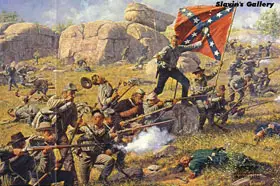Civil War Battles |
Colonial Wars |
American Wars |
Link To This Page — Contact Us —
The Fight at Devil's Den
July 1-3, 1863 in Gettysburg, Pennsylvania
 |
Devil's Den was the extreme left of the III Corps line, manned by the large brigade (six regiments and two companies of sharpshooters, 2,200 men in all) of Brigadier General J. H. Hobart Ward, in Maj. Gen. David B. Birney's division. It was the southern end of Houck's Ridge, a modest elevation on the northwest side of Plum Run Valley, made distinctive by piles of huge boulders. These boulders were not the direct avenue of approach used by the Confederates. The 3rd Arkansas and the 1st Texas drove through Rose Woods and hit Ward's line head-on. His troops had lacked the time or inclination to erect breastworks, and for over an hour both sides participated in a standup fight of unusual ferocity. In the first 30 minutes, the 20th Indiana lost more than half of its men. Its colonel was killed and its lieutenant colonel wounded. The 86th New York also lost its commander. The commander of the 3rd Arkansas fell wounded, one of 182 casualties in his regiment.
Meanwhile, the two regiments from Law's brigade that had split from the column advancing to the Round Tops pushed up Plum Run Valley and threatened to turn Ward's flank. Their target was the 4th Maine and the 124th New York, defending the 4th New York Independent artillery battery commanded by Captain James Smith, whose fire was causing considerable disruption in Law's brigade's advance. The pressure grew great enough that Ward needed to call the 99th Pennsylvania from his far right to reinforce his left. The commander of the 124th New York, Colonel Augustus Van Horne Ellis, and his major, James Cromwell, decided to counterattack. They mounted their horses despite the protests of soldiers who urged them to lead more safely on foot. Maj. Cromwell said, "The men must see us today." They led the charge of their "Orange Blossoms" regiment to the west, down the slope of Houck's Ridge through a triangular field surrounded by a low stone fence, sending the 1st Texas reeling back 200 yards. But both Colonel Ellis and Major Cromwell were shot dead as the Texans rallied with a massed volley; and the New Yorkers retreated to their starting point, with only 100 survivors from the 283 they started with. As reinforcements from the 99th Pennsylvania arrived, Ward's brigade retook the crest.
The second wave of Hood's assault was the brigades of Henry Benning and George "Tige" Anderson. They detected a gap in Birney's division line: to Ward's right, there was a considerable gap before the brigade of Régis de Trobriand began. Anderson's line smashed into Trobriand and the gap at the southern edge of the Wheatfield. Trobriand wrote that the Confederates "converged on me like an avalanche, but we piled all the dead and wounded men in our front." The Union defense was fierce, and Anderson's brigade pulled back; its commander was wounded in the leg and was carried from the battle.
Two of Benning's Confederate regiments, the 2nd and 17th Georgia, moved down Plum Run Valley around Ward's flank. They received murderous fire from the 99th Pennsylvania and Hazlett's battery on Little Round Top, but they kept pushing forward. Capt. Smith's New York battery was under severe pressure from three sides, but its supporting infantry regiments were suffering severe casualties and could not protect it. Three 10-pound Parrott rifles were lost to the 1st Texas, and they were used against Union troops the next day.
Birney scrambled to find reinforcements. He sent the 40th New York and 6th New Jersey from the Wheatfield into Plum Run Valley to block the approach into Ward's flank. They collided with Benning's and Law's men in rocky, broken ground that the survivors would remember as the "Slaughter Pen". (Plum Run itself was known as "Bloody Run"; Plum Run Valley as the "Valley of Death".) As the men of the 40th fell back under relentless pressure, the 6th New Jersey covered their withdrawal and lost a third of its men in the process.
The pressure on Ward's brigade was eventually too great, and he was forced to call for a retreat. Hood's division secured Devil's Den and the southern part of Houck's Ridge. The center of the fighting shifted to the northwest, to Rose Woods and the Wheatfield, while five regiments under Evander Law assaulted Little Round Top to the east. Benning's men spent the next 22 hours on Devil's Den, firing across the Valley of Death on Union troops massed on Little Round Top.
The assaults by Hood's brigades were classic, tough infantry fights. Of 2,423 Union troops engaged, there were 821 casualties (138 killed, 548 wounded, 135 missing); the 5,525 Confederates lost 1,814 (329, 1,107, 378).
